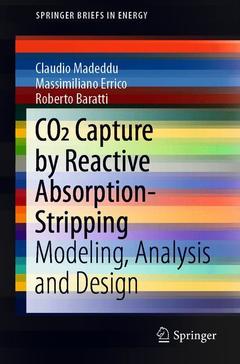CO2 Capture by Reactive Absorption-Stripping, 1st ed. 2019 Modeling, Analysis and Design SpringerBriefs in Energy Series
Langue : Anglais
Auteurs : Madeddu Claudio, Errico Massimiliano, Baratti Roberto

This book focuses on modelling issues and their implications for the correct design of reactive absorption?desorption systems. In addition, it addresses the case of carbon dioxide (CO2) post-combustion capture in detail. The book proposes a new perspective on these systems, and provides technological solutions with comparisons to previous treatments of the subject. The model that is proposed is subsequently validated using experimental data.
In addition, the book features graphs to guide readers with immediate visualizations of the benefits of the methodology proposed. It shows a systematic procedure for the steady-state model-based design of a CO2 post-combustion capture plant that employs reactive absorption-stripping, using monoethanolamine as the solvent. It also discusses the minimization of energy consumption, both through the modification of the plant flowsheet and the set-up of the operating parameters.
The book offers a unique source of information for researchers and practitioners alike, as it also includes an economic analysis of the complete plant. Further, it will be of interest to all academics and students whose work involves reactive absorption-stripping design and the modelling of reactive absorption-stripping systems.
Part I: Process Modeling.- Part II: Industrial-Scale Plant Analysis and Design.
Claudio Madeddu, PhD in Industrial Engineering, works in the field of reactive absorption-stripping system modelling, with a particular focus on CO2 post-combustion capture. During his PhD he developed skills in process modelling in the Aspen Plus environment and for absorption-stripping plant configurations.
Massimiliano Errico, Associate Professor at the Department of Chemical, Biotechnology and Environmental Engineering of Southern Denmark University, has considerable expertise in the process synthesis of separation processes. He has helped to define systematic methodologies to predict, in a complete way, process alternatives for multicomponent separations. He has also applied his methodologies to the separation of biofuels where azeotropic mixtures play an important role.
Roberto Baratti, Full Professor at the Mechanical, Chemical and Material Engineering Department of the University of Cagliari, has acquired expertise spanning various fields of Chemical Engineering: unit operations, chemical reaction engineering, transport phenomena, optimization, and stochastic and process control. His work in the field of process control is mainly devoted to the development of software sensors, either structured (EKF and GO) or not structured (Artificial Neural Networks); to model reduction for control purposes and monitoring; and to the control of distillation columns, crystallization and chemical reactors. In turn, his work in the field of process modelling is mainly devoted to developing chemical, biochemical reactor, crystallization, distillation/adsorption column models, and stochastic modelling.
Describes the modelling of reactive absorption–desorption systems in CO2 capture
Includes a wealth of graphs and illustrations
Provides practical guidance on applying the proposed model in the Aspen Plus simulator
Date de parution : 01-2019
Ouvrage de 90 p.
15.5x23.5 cm
Thèmes de CO2 Capture by Reactive Absorption-Stripping :
© 2024 LAVOISIER S.A.S.



